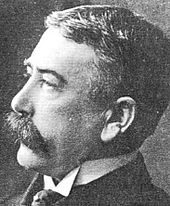使用者:Harimau Gelisah/沙盒
語言理論[編輯]

人文語言學[編輯]
人文語言學的基本原則是語言是人創造的發明。 語言研究的符號學傳統認為語言是一種符號系統,它產生於意義和形式的相互作用。[1]語言結構的組織被認為是計算性的。[2] 語言學本質上被認為與社會和文化科學有關,因為不同的語言是由社會互動中的社區塑造的。[3] 代表語言人文觀的語言學流派包括結構語言學等。[4]
結構分析意味著解剖每一層:語音、形態、句法和話語,到最小的單位。 這些被收集到清單中(例如音素、語素、詞彙類、短語類型),以研究它們在結構和層的層次結構中的相互聯繫。[5] 功能分析為結構分析增加了語義角色和每個單元的其他功能角色的分配。 例如,名詞短語可以作為句子的語法主語或賓語,或者作為語義代理或患者。[6]
功能語言學或功能語法是結構語言學的一個分支。 在人文背景下,結構主義和功能主義這兩個術語與它們在其他人文科學中的含義有關。 形式結構主義和功能結構主義之間的區別在於它們對為什麼語言具有它們所具有的屬性這一問題的回答。 功能解釋意味著語言是交流的工具,或者交流是語言的主要功能。 因此,語言形式是根據它們的功能價值或用途來解釋的。 其他結構主義方法認為形式遵循雙邊和多層語言系統的內部機制。[7]
生物語言學[編輯]
認知語言學和生成語法等方法研究語言認知,以期揭示語言的生物學基礎。 在生成語法中,這些基礎被認為來自先天的語法知識。 因此,該方法的核心關注點之一是發現語言知識的哪些方面是遺傳的。[8][9]
相反,認知語言學拒絕先天語法的概念,並研究人類思維如何從事件圖式中創建語言結構[10] 以及認知約束和偏見對人類語言的影響。[11] 與神經語言編程類似,語言是通過感官來接觸的。[12][13][14] 認知語言學家通過尋找與感覺運動圖式相關的表達來研究知識的體現。[15]
一種密切相關的方法是進化語言學,[16] 其中包括將語言單位作為文化複製器的研究。[17][18] 可以研究語言如何複製和適應個人或語言社區的思想。[19][20] 構造語法是將模因概念應用於句法研究的框架。[21][22][23][24]
生成方法和進化方法有時被稱為形式主義和功能主義。[25] 但是,術語的這種用法與人文學科不同。 [26]
- ^ Nöth, Winfried. Handbook of Semiotics (PDF). Indiana University Press. 1990. ISBN 978-0-253-20959-7.
- ^ Hjelmslev, Louis. Prolegomena to a Theory of Language. University of Wisconsin Press. 1969 [First published 1943]. ISBN 0-299-02470-9.
- ^ de Saussure, Ferdinand. Course in general linguistics (PDF). New York: Philosophy Library. 1959 [First published 1916]. ISBN 978-0-231-15727-8.
- ^ Austin, Patrik. Theory of language: a taxonomy. SN Social Sciences. 2021, 1 (3) [2021-08-02]. doi:10.1007/s43545-021-00085-x.
- ^ Schäfer, Roland. Einführung in die grammatische Beschreibung des Deutschen (2nd ed.). Berlin: Language Science Press. 2016. ISBN 978-1-537504-95-7.
- ^ Halliday & Matthiessen. An Introduction to Functional Grammar (3rd ed.) (PDF). London: Hodder. 2004. ISBN 0-340-76167-9.
- ^ Daneš, František. On Prague school functionalism in linguistics. Dirven & Fried (編). Functionalism in Linguistics. John Benjamins. 1987: 3–38. ISBN 978-90-272-1524-6.
- ^ Everaert, Huybregts, Chomsky, Berwick & Bolhuis. Structures, not strings: linguistics as part of the cognitive sciences. Trends in Cognitive Sciences. 2015, 19 (12): 729–743 [2021-08-03]. PMID 26564247. doi:10.1016/j.tics.2015.09.008.
- ^ Chomsky, Noam. The Minimalist Program (2nd ed.). MIT Press. 2015. ISBN 978-0-262-52734-7.
- ^ Arbib, Michael A. Language evolution – an emergentist perspective. MacWhinney & O'Grady (編). Handbook of Language Emergence. Wiley. 2015: 81–109. ISBN 978-1-118-34613-6.
- ^ Tobin, Vera. Where do cognitive biases fit into cognitive linguistics? (PDF). Borkent (編). Language and the Creative Mind. Chicago University Press. 2014: 347–363. ISBN 978-90-272-8643-7.
- ^ del Carmen Guarddon Anelo, María. Metaphors and neuro-linguistic programming. The International Journal of Interdisciplinary Social Sciences. 2010, 5 (7): 151–162. doi:10.18848/1833-1882/CGP/v05i07/51812.
- ^ Ibarretxe-Antuñano, Iraide. MIND-AS-BODY as a Cross-linguistic Conceptual Metaphor. Miscelánea. 2002, 25 (1): 93–119 [2020-07-15].
- ^ Gibbs & Colston. The cognitive psychological reality of image schemas and their transformations. Cognitive Linguistics. 1995, 6 (4): 347–378. doi:10.1515/cogl.1995.6.4.347.
- ^ Luodonpää-Manni, Penttilä & Viimaranta. Introduction. Luodonpää-Manni & Viimaranta (編). Empirical Approaches to Cognitive Linguistics: Analyzing Real-Life Data. Cambridge University Press. 2017 [2020-06-30]. ISBN 978-1-4438-7325-3.
- ^ Pleyer & Winters. Integrating cognitive linguistics and language evolution research. Theoria et Historia Scientiarum. 2014, 11: 19–44 [2021-08-03]. doi:10.12775/ths-2014-002.
- ^ Evans & Green. Cognitive Linguistics. An Introduction. Routledge. 2006. ISBN 0-7486-1831-7.
- ^ Croft, William. Evolutionary linguistics (PDF). Annual Review of Anthropology. 2008, 37: 219–234 [2021-08-03]. doi:10.1146/annurev.anthro.37.081407.085156.
- ^ Cornish, Tamariz & Kirby. Complex adaptive systems and the origins of adaptive structure: what experiments can tell us (PDF). Language Learning. 2009, 59: 187–205 [2021-08-03]. doi:10.1111/j.1467-9922.2009.00540.x.
- ^ Sinnemäki & Di Garbo. Language Structures May Adapt to the Sociolinguistic Environment, but It Matters What and How You Count: A Typological Study of Verbal and Nominal Complexity. Frontiers in Psychology. 2018, 9: 187–205. PMC 6102949
 . PMID 30154738. doi:10.3389/fpsyg.2018.01141.
. PMID 30154738. doi:10.3389/fpsyg.2018.01141.
- ^ Dahl, Östen. Grammaticalization and the life cycles of constructions. RASK – Internationalt Tidsskrift for Sprog og Kommunikation. 2001, 14: 91–134.
- ^ Kirby, Simon. Transitions: the evolution of linguistic replicators. Smith (編). The Language Phenomenon (PDF). The Frontiers Collection. Springer. 2013: 121–138 [2020-03-04]. ISBN 978-3-642-36085-5. doi:10.1007/978-3-642-36086-2_6.
- ^ Zehentner, Eva. Competition in Language Change: the Rise of the English Dative Alternation. De Gruyter Mouton. 2019. ISBN 978-3-11-063385-6.
- ^ MacWhinney, Brian. Introduction – language emergence. MacWhinney & O'Grady (編). Handbook of Language Emergence. Wiley. 2015: 1–31. ISBN 978-1-118-34613-6.
- ^ Nettle, Daniel. Functionalism and its difficulties in biology and linguistics. Darnell (編). Functionalism and Formalism in linguistics, 1. Studies in Language Companion Series 41. John Benjamins. 1999: 445–468. ISBN 978-1-55619-927-1. doi:10.1075/slcs.41.21net.
- ^ Croft, William. Functional Approaches to Grammar. Wright (編). International Encyclopedia of the Social and Behavioral Sciences 9 2nd. Elsevier. 2015: 6323–6330. ISBN 978-0-08-097087-5. doi:10.1016/B978-0-08-097086-8.53009-8.
